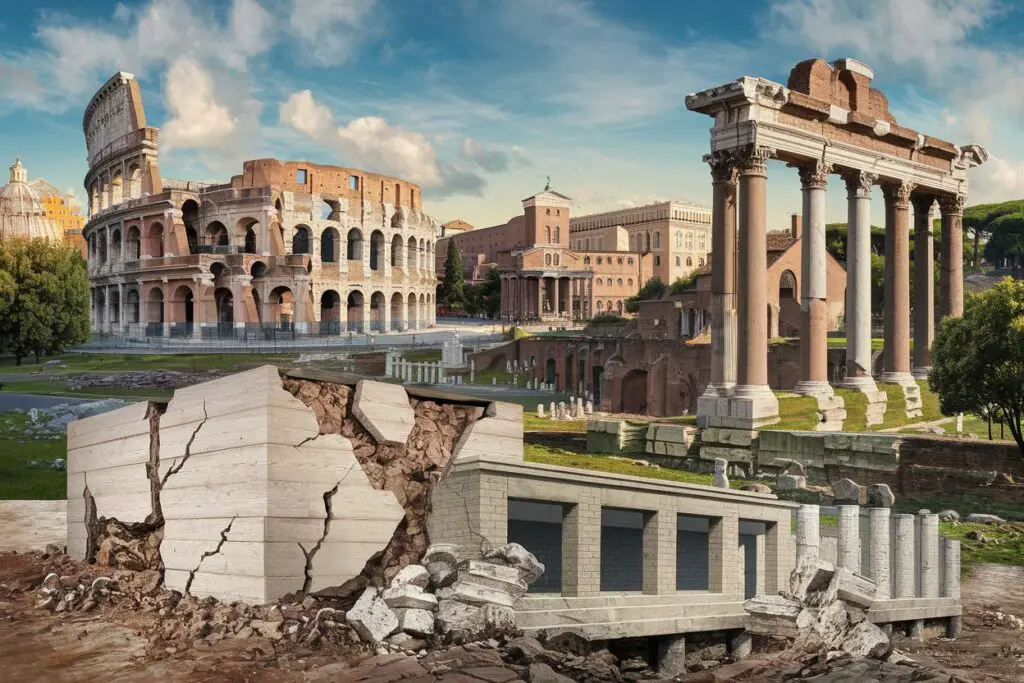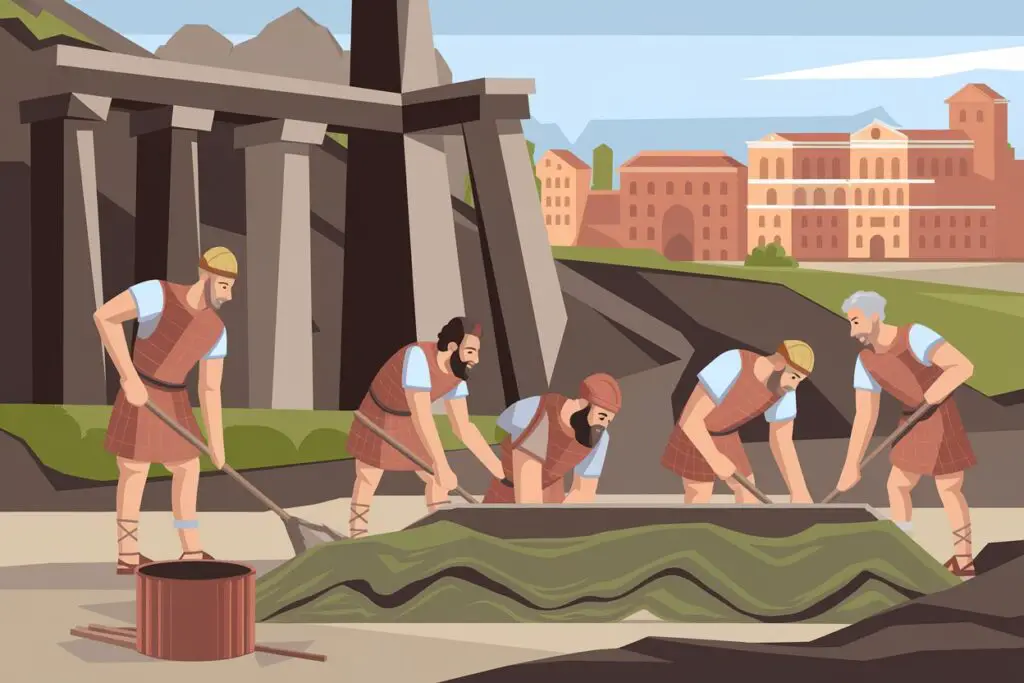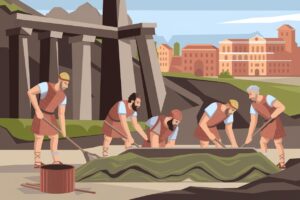For centuries, engineers and historians alike have marveled at the endurance of ancient Roman concrete, a material that has withstood the ravages of time while many modern structures crumble in mere decades. The secret to its resilience lies not just in its ingredients but in the sophisticated techniques the Romans employed. Unlike today’s Portland cement, which is prone to cracking and deterioration, Roman concrete possessed an almost self-healing quality. But what made it so unique?
At the heart of Roman concrete’s durability was its composition. The primary binding agent was a mixture of volcanic ash, known as pozzolana, combined with quicklime and various aggregates such as rock fragments, ceramic pieces, and even brick rubble. This blend triggered a pozzolanic reaction, forming strong calcium-silicate-hydrate (C-S-H) bonds that reinforced the material over time. Researchers from MIT, Harvard, and European institutions recently discovered another crucial factor: lime clasts, or small chunks of quicklime that had previously been dismissed as a sign of poor mixing. In reality, these lime clasts played a pivotal role in the concrete’s longevity.

Through a process known as hot mixing, the Romans heated the quicklime to high temperatures before adding it to the mixture. This resulted in the formation of calcium-rich compounds that, when exposed to water, could reactivate and fill in cracks, effectively “healing” the material. In modern experiments, concrete samples incorporating this ancient method showed the ability to repair cracks within two weeks—something conventional concrete cannot achieve. This self-healing property made Roman concrete particularly well-suited for structures exposed to harsh conditions, such as aqueducts, seawalls, and harbors.
Perhaps even more astonishing is how Roman concrete reacted with seawater. When submerged, the volcanic ash and lime clasts interacted with the saltwater, forming rare minerals like tobermorite and phillipsite—both of which enhanced the concrete’s strength over time rather than weakening it. This explains why structures like the Pantheon and the Portus Cosanus harbor remain intact after nearly two millennia.
Modern scientists are now looking to revive and adapt these ancient techniques. By studying the unique properties of Roman concrete, researchers hope to develop more sustainable, long-lasting building materials that could reduce maintenance costs and lower carbon emissions from cement production. Could the past hold the key to the future of construction? If Roman ingenuity is any indication, the answer might just be yes.
What Made Roman Concrete Different from Modern Cement?
At first glance, Roman concrete and modern cement might seem like variations of the same material. After all, both serve as essential building components. But the secret behind the astonishing longevity of Roman structures lies in their unique composition and chemical properties—qualities that set them apart from today’s concrete, which often deteriorates within decades. Unlike modern concrete, which relies on Portland cement as its primary binder, Roman concrete, or opus caementicium, was made using a combination of volcanic ash (pozzolana), quicklime, and a diverse mix of rock, ceramic fragments, and brick rubble. This blend not only gave Roman concrete exceptional durability but also allowed it to develop self-healing properties over time.

One of the most significant differences was the use of “hot mixing” with quicklime, a process recently identified by researchers at MIT and Harvard. By mixing quicklime at high temperatures, the Romans inadvertently created lime clasts—small calcium-rich deposits within the concrete. When cracks formed, these lime clasts reacted with water, triggering a chemical process that allowed the material to repair itself. Modern concrete lacks this self-healing ability, making it far more susceptible to environmental damage and structural weaknesses. Furthermore, while modern concrete sets quickly, Roman concrete cured over an extended period, allowing it to gain strength gradually. This slow hydration process contributed to its remarkable resilience, particularly in marine environments where structures like harbor piers and aqueducts have remained intact for over two millennia.
Another key distinction lies in the role of pozzolanic reactions. The volcanic ash used in Roman concrete contained silicate compounds that, when mixed with lime and water, formed calcium silicate hydrates (C-S-H) and calcium aluminate hydrates (C-A-H). These compounds enhanced the concrete’s binding properties, making it more resistant to cracking and chemical degradation. This reaction is what allowed Roman concrete to thrive in saltwater environments—a feat modern concrete struggles to achieve without extensive reinforcement. In contrast, Portland cement, the main ingredient in modern concrete, is manufactured by heating limestone and clay at high temperatures, a process that releases significant amounts of carbon dioxide. Not only is this method environmentally costly, but it also produces a material that is far less durable than its ancient counterpart.
The structural approach also differed. Roman engineers did not pour concrete as we do today; instead, they laid it in layers, incorporating different aggregate materials based on the structural demands of each section. Take the Pantheon’s dome, for example: its lower sections contain heavier, denser stone, while the upper layers incorporate lightweight pumice, reducing overall stress on the structure. This strategic layering contributed to the building’s stability and longevity, a technique rarely employed in modern construction.
The durability of Roman concrete wasn’t just a happy accident—it was the result of centuries of empirical knowledge, refined techniques, and a deep understanding of available materials. While modern concrete has certainly revolutionized construction, its short lifespan and environmental impact have led researchers to reconsider ancient methods. With recent discoveries shedding light on the self-healing properties of Roman concrete, scientists are now exploring ways to integrate these principles into contemporary building materials, potentially paving the way for more sustainable and longer-lasting infrastructure.
The Role of Volcanic Ash in Rome’s Lasting Structures
When it comes to ancient Roman engineering, one ingredient stands out as a game-changer: volcanic ash. This naturally occurring material, abundant in regions like Pozzuoli near Naples, was a cornerstone of Roman concrete’s unparalleled durability. Known as pozzolana, this ash was mixed with lime and aggregate to create a concrete that not only withstood the test of time but also grew stronger with age. Unlike modern Portland cement, which can deteriorate due to chemical reactions with environmental elements, Roman concrete benefited from a unique process called the pozzolanic reaction. This chemical interaction between volcanic ash, lime, and water led to the formation of incredibly stable compounds, such as calcium silicate hydrate (C-S-H) and calcium aluminate hydrate (C-A-H), which tightly bonded the mixture together.
But here’s where it gets even more fascinating: volcanic ash didn’t just make Roman concrete strong—it made it self-healing. When cracks formed in structures exposed to seawater, the minerals within the ash reacted with the infiltrating water, triggering the formation of new binding materials like aluminum tobermorite and phillipsite. These compounds filled the cracks, effectively repairing the concrete from within. This phenomenon explains why structures like Rome’s Pantheon and the Colosseum, despite being battered by the elements for nearly two millennia, remain standing today.
The Romans’ ingenious use of volcanic ash also had environmental and structural advantages. Their concrete was more resistant to seismic activity and harsh weather conditions, making it ideal for monumental buildings, aqueducts, and even harbors. In contrast, modern concrete, while initially strong, tends to degrade over time due to chemical reactions and environmental exposure. The rediscovery of this ancient technique has sparked interest among researchers, including teams at MIT and Harvard, who are now exploring ways to integrate pozzolanic materials into contemporary construction. If successfully adapted, this ancient innovation could revolutionize modern infrastructure, reducing maintenance costs and significantly lowering carbon emissions associated with cement production.
Iconic Roman Structures That Have Stood the Test of Time
The endurance of Roman architecture is nothing short of remarkable. While modern buildings often require continuous maintenance and repairs, many ancient Roman structures remain standing after nearly two millennia. This resilience is largely due to the innovative use of Roman concrete, a material that has proven vastly superior to modern Portland cement. But which structures best exemplify this durability? Let’s explore some of the most iconic Roman buildings that showcase the brilliance of ancient engineering.
The Pantheon: A Marvel of Concrete Engineering
The Pantheon in Rome, completed around 126 CE under Emperor Hadrian, is perhaps the most famous example of Roman concrete’s longevity. Its massive unreinforced concrete dome, spanning 142 feet in diameter, remains the largest of its kind in the world. The secret to its durability lies in the unique composition of its concrete, which includes volcanic ash (pozzolana) that strengthens over time. The Pantheon has survived earthquakes, floods, and centuries of urban development, largely because of its advanced material composition and strategic maintenance, including its conversion into a church in the 7th century.
The Colosseum: A Testament to Amphitheater Design
Built between 72 and 80 CE under Emperor Vespasian and his successor Titus, the Colosseum is another iconic Roman structure that has withstood the test of time. Originally capable of seating around 50,000 spectators, this massive amphitheater was primarily made of travertine limestone and Roman concrete. Despite suffering damage from earthquakes and stone robbers over the centuries, a significant portion of the structure remains intact. Its longevity is partly due to the self-healing properties of Roman concrete, which allowed cracks to be naturally filled over time.
The Aqueduct of Segovia: A Masterpiece of Hydraulic Engineering
One of the most impressive Roman aqueducts still standing today is the Aqueduct of Segovia in Spain. Constructed during the early 2nd century CE, it features 165 arches and stretches for over 728 meters. What makes this structure particularly astonishing is that it was built without the use of mortar—each precisely cut stone fits together perfectly, demonstrating the exceptional engineering skills of the Romans. The combination of Roman concrete and carefully selected stone has allowed the aqueduct to remain functional for nearly 2,000 years.
Maison Carrée: A Perfectly Preserved Roman Temple
The Maison Carrée in Nîmes, France, is one of the best-preserved Roman temples in the world. Commissioned by Marcus Vipsanius Agrippa around 20 BCE, this temple was dedicated to Emperor Augustus’ heirs, Gaius and Lucius Caesar. Its survival can be attributed to continuous use throughout history, having served as a church and later as a museum. The temple’s structure, built with a mix of limestone and Roman concrete, has remained remarkably intact, showcasing the strength of ancient Roman building techniques.
The Tower of Hercules: The Oldest Functional Lighthouse
The Tower of Hercules, located in A Coruña, Spain, is the only Roman lighthouse still in operation today. Originally built in the 2nd century CE, it was later renovated and extended in 1788. The tower stands 180 feet tall and continues to serve as a navigational aid for ships. Its resilience is a direct result of the high-quality Roman concrete used in its construction, which has allowed it to withstand harsh coastal weather conditions for nearly two millennia.
Diocletian’s Palace: A Roman Fortress Turned Modern City
Diocletian’s Palace in Split, Croatia, is one of the largest Roman palatial complexes still standing today. Built between 295 and 305 CE as a retirement residence for Emperor Diocletian, the palace was constructed using Roman concrete mixed with local limestone and brick. Over time, the structure was repurposed into a medieval town, with many of its original walls and buildings still in use today. The palace’s durability is a testament to the strength of Roman construction materials and techniques.
These structures not only highlight the ingenuity of Roman engineering but also demonstrate the extraordinary durability of Roman concrete. Unlike modern cement, which deteriorates over time due to environmental exposure, Roman concrete has proven to be self-healing and highly resistant to degradation. As researchers continue to study its composition, there is growing interest in reviving these ancient techniques to improve the longevity of modern infrastructure.
Why Does Modern Concrete Deteriorate So Quickly?
Modern concrete, despite its widespread use, is surprisingly fragile compared to its ancient Roman counterpart. The primary culprit? The heavy reliance on Portland cement. Unlike the mineral-rich mixtures of Roman concrete, Portland cement lacks the complex crystalline structures that made ancient materials so resilient. Over time, this leads to increased porosity, allowing water and chemicals to penetrate, corrode reinforcements, and weaken the structure from within.
Another major issue is rapid calcium leaching. Modern concrete is highly susceptible to chemical reactions with environmental elements, particularly in coastal or high-moisture areas. As water seeps in, it dissolves calcium hydroxide, a key binding agent, leading to micro-cracks and gradual disintegration. Unlike Roman concrete, which could self-heal through chemical interactions with seawater, today’s materials lack this regenerative ability.
Construction practices further compound the problem. Many modern buildings prioritize cost and speed over longevity, using standardized processes that often ignore long-term durability. Poor mixing techniques, inadequate curing times, and subpar materials contribute to structural weaknesses. The result? Buildings that require frequent repairs and have significantly shorter lifespans than structures built thousands of years ago. Understanding these flaws is key to developing more durable, sustainable materials for the future.
The Science of Self-Healing Roman Concrete
For centuries, engineers and scientists have puzzled over why ancient Roman concrete endures while modern structures crumble in just a few decades. The answer lies in the remarkable self-healing properties of Roman concrete, a feature that was not fully understood until recent studies by researchers from MIT, Harvard, and European institutions. Unlike modern concrete, which deteriorates once cracks form, Roman concrete has a built-in repair mechanism that allows it to mend itself over time. But how exactly does this ancient material achieve such longevity?
The key ingredient is quicklime (calcium oxide), which the Romans used in a process known as hot mixing. This technique, recently identified in Roman concrete samples, involved mixing quicklime with volcanic ash and water at high temperatures. The result was the formation of lime clasts, small white mineral chunks that were previously dismissed as evidence of poor mixing. However, new research has shown that these lime clasts are essential to the concrete’s self-healing process. When cracks form, water seeps in and dissolves the calcium-rich lime clasts, creating a solution that recrystallizes as calcium carbonate, effectively sealing the fractures and preventing further deterioration.
To test this theory, scientists replicated Roman-style concrete using the ancient hot-mixing technique. When they deliberately cracked the material and exposed it to water, the fractures healed within just two weeks—a phenomenon absent in conventional concrete. These findings, published in Science Advances, suggest that reviving Roman construction techniques could revolutionize modern infrastructure by significantly extending the lifespan of buildings and reducing maintenance costs. With cement production currently responsible for 8% of global CO₂ emissions, adopting self-healing concrete could also be a game-changer for environmental sustainability.
By uncovering the science behind this ancient innovation, researchers are not only solving a long-standing historical mystery but also offering practical solutions for the future of construction. As MIT professor Admir Masic and his team work toward commercializing Roman-inspired concrete, we may soon see a resurgence of this time-tested material in modern architecture. Could the secret to sustainable infrastructure have been hidden in ancient ruins all along?
Can We Recreate Roman Concrete Today?
For centuries, historians and engineers marveled at the durability of ancient Roman concrete, wondering if modern science could replicate its resilience. The answer? Yes—but it requires a deep dive into the chemistry and craftsmanship of the past. Researchers from MIT, Harvard, and European institutions have unlocked the secrets of this ancient material, revealing that its unique self-healing properties stem from a technique called “hot mixing” with quicklime. Unlike modern Portland cement, which degrades over time, Roman concrete was designed to heal itself when cracks formed, thanks to calcium-rich compounds that reacted with water to create new mineral deposits.
In laboratory settings, scientists have successfully recreated Roman concrete by incorporating quicklime and volcanic ash, mimicking the methods used by ancient builders. Admir Masic and his team at MIT demonstrated that concrete mixed this way could self-repair within two weeks—something unheard of in modern construction. The potential applications are vast: from longer-lasting infrastructure to reduced carbon emissions, since cement production is a major contributor to greenhouse gases. While integrating these ancient techniques into mainstream construction is still a work in progress, the findings suggest that the future of sustainable building might lie in the wisdom of the past.
How Ancient Innovations Could Revolutionize Modern Construction
The ingenuity of ancient Roman builders might just hold the key to solving some of modern construction’s biggest challenges. Unlike today’s concrete, which often deteriorates within a century, Roman concrete structures have endured for over 2,000 years. The secret? A unique blend of volcanic ash, lime, and seawater that not only made the material incredibly durable but also gave it self-healing properties. Recent research from MIT, Harvard, and European institutions has revealed that these ancient techniques allowed cracks to seal themselves over time, drastically extending the lifespan of structures. If modern engineers can replicate this process, it could revolutionize infrastructure by reducing maintenance costs and increasing sustainability.
One of the most promising aspects of Roman concrete is its potential to cut down carbon emissions. Cement production today is responsible for nearly 8% of global CO₂ emissions, largely due to the energy-intensive process of heating limestone at high temperatures. The Romans, however, used a technique called “hot mixing” with quicklime, which not only strengthened the concrete but also reduced the need for additional energy inputs. If adapted, this method could lead to a more eco-friendly alternative to Portland cement, the dominant material in modern construction.
Beyond durability, Roman innovations extended to architectural sustainability. Ancient cities like Pompeii incorporated passive cooling techniques, such as sloped roofs and light-colored surfaces, to regulate indoor temperatures. These methods, which required no electricity, could inspire modern architects to rethink energy-efficient design in an era of climate change. Additionally, projects like the EU-funded ReSHEALience initiative are already applying principles from Roman concrete to develop ultra-durable materials for marine environments, reducing the need for frequent repairs in coastal infrastructure.
The commercialization of Roman-inspired concrete is already underway. MIT’s Prof. Admir Masic and his team are actively exploring ways to integrate these ancient techniques into modern applications. If successful, this could lead to roads, bridges, and buildings that last centuries instead of decades. By looking to the past, engineers may be able to create a more sustainable, resilient future—one where infrastructure doesn’t just withstand time but thrives because of it.
What the Romans Can Teach Us About Sustainable Building
The Romans weren’t just master builders—they were pioneers of sustainable construction. Unlike modern concrete, which deteriorates within decades, Roman concrete has endured for over 2,000 years, thanks to its unique composition and self-healing properties. Their secret? A mix of locally sourced volcanic ash, lime, and seawater, which not only reduced environmental impact but also enhanced durability. By contrast, today’s cement production accounts for nearly 8% of global CO₂ emissions, largely due to the energy-intensive process of heating limestone to extreme temperatures. If we adopted Roman techniques, we could slash emissions while extending the lifespan of our infrastructure.
One of the most remarkable aspects of Roman concrete was its ability to repair itself. Researchers from MIT and Harvard discovered that Roman builders used “hot mixing” with quicklime, creating calcium-rich compounds that reacted with water to seal cracks over time (MIT News). This self-healing property could revolutionize modern construction by reducing maintenance costs and material waste. Additionally, the Romans optimized their structures for compressive strength, allowing them to withstand seismic activity and harsh environments.
By reintroducing these ancient innovations, we could build more resilient, low-carbon cities. Projects like the EU-funded ReSHEALience initiative are already exploring ways to integrate self-healing concrete into modern infrastructure. The lesson from Rome is clear: sustainability isn’t just about new technology—it’s also about rediscovering the wisdom of the past.







